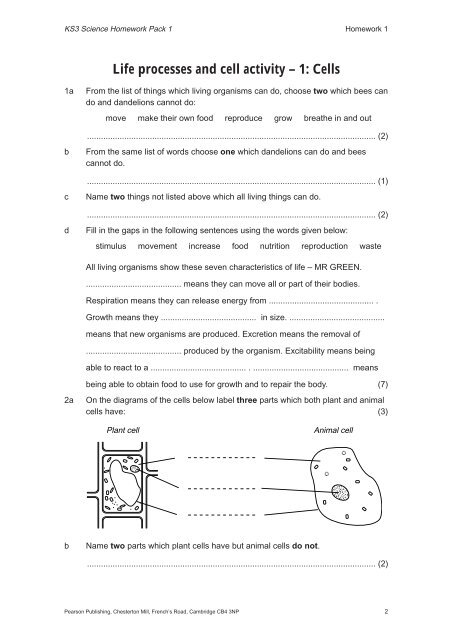Life processes and cell activity â 1: Cells - Pearson Publishing
Life processes and cell activity â 1: Cells - Pearson Publishing
Life processes and cell activity â 1: Cells - Pearson Publishing
Create successful ePaper yourself
Turn your PDF publications into a flip-book with our unique Google optimized e-Paper software.
KS3 Science Homework Pack 1 Homework 1<br />
<strong>Life</strong> <strong>processes</strong> <strong>and</strong> <strong>cell</strong> <strong>activity</strong> – 1: <strong>Cells</strong><br />
1a<br />
From the list of things which living organisms can do, choose two which bees can<br />
do <strong>and</strong> d<strong>and</strong>elions cannot do:<br />
move make their own food reproduce grow breathe in <strong>and</strong> out<br />
............................................................................................................................ (2)<br />
b<br />
From the same list of words choose one which d<strong>and</strong>elions can do <strong>and</strong> bees<br />
cannot do.<br />
............................................................................................................................ (1)<br />
c<br />
Name two things not listed above which all living things can do.<br />
............................................................................................................................ (2)<br />
d<br />
Fill in the gaps in the following sentences using the words given below:<br />
stimulus movement increase food nutrition reproduction waste<br />
All living organisms show these seven characteristics of life – MR GREEN.<br />
......................................... means they can move all or part of their bodies.<br />
Respiration means they can release energy from ............................................. .<br />
Growth means they ......................................... in size. .........................................<br />
means that new organisms are produced. Excretion means the removal of<br />
......................................... produced by the organism. Excitability means being<br />
able to react to a ......................................... . ......................................... means<br />
being able to obtain food to use for growth <strong>and</strong> to repair the body. (7)<br />
2a<br />
On the diagrams of the <strong>cell</strong>s below label three parts which both plant <strong>and</strong> animal<br />
<strong>cell</strong>s have: (3)<br />
Plant <strong>cell</strong><br />
Animal <strong>cell</strong><br />
,<br />
,<br />
,,<br />
,,<br />
b<br />
Name two parts which plant <strong>cell</strong>s have but animal <strong>cell</strong>s do not.<br />
............................................................................................................................ (2)<br />
<strong>Pearson</strong> <strong>Publishing</strong>, Chesterton Mill, French’s Road, Cambridge CB4 3NP 2
KS3 Science Homework Pack 1<br />
Homework 1 (continued)<br />
c<br />
Join together the parts of the <strong>cell</strong>s <strong>and</strong> their correct functions using a ruled line:<br />
Part of <strong>cell</strong><br />
Function<br />
Chloroplasts • • Where chemical reactions take place<br />
Nucleus • • Controls what enters <strong>and</strong> leaves the <strong>cell</strong><br />
Cell membrane • • Absorbs light for photosynthesis<br />
Cytoplasm • • Keeps the shape of a plant <strong>cell</strong><br />
Cell wall • • Controls the <strong>cell</strong>’s activities (5)<br />
3 <strong>Cells</strong> become specialised to perform a particular function. For each <strong>cell</strong> below<br />
label a part which allows it to perform its function well <strong>and</strong> also describe the<br />
function it performs.<br />
Chloroplasts<br />
which absorb<br />
light used for<br />
photosynthesis<br />
Palisade <strong>cell</strong><br />
Root hair <strong>cell</strong><br />
(2)<br />
Ciliated epithelium<br />
4 Why do root hair <strong>cell</strong>s not have chloroplasts?<br />
(2)<br />
............................................................................................................................ (1)<br />
5 Euglena is a single <strong>cell</strong>ed organism. It lives in pond water. Euglena makes a<br />
sugar called glucose.<br />
a<br />
Give the name of the process in which Euglena makes glucose.<br />
................................................................................................................... (1)<br />
b<br />
Euglena produces starch grains from glucose. Explain what will happen to<br />
the number of starch grains in the <strong>cell</strong> if Euglena is kept in the dark.<br />
........................................................................................................................<br />
................................................................................................................... (2)<br />
Total marks = 30<br />
<strong>Pearson</strong> <strong>Publishing</strong>, Chesterton Mill, French’s Road, Cambridge CB4 3NP 3
KS3 Science Homework Pack 1 Homework 10<br />
Humans as organisms – 8: Breathing<br />
1 Our breathing system allows us to move air in <strong>and</strong> out of our lungs.<br />
a<br />
On the diagram of the thorax or chest below write the correct label by each<br />
labelling line. One has been done for you: (6)<br />
Trachea<br />
b<br />
Match up the parts of the breathing system with their correct function by writing<br />
the correct letter next to the functions listed below. Each may be used once, more<br />
than once or not at all. The first one has been done for you. (9)<br />
A – trachea B – diaphragm C – bronchi<br />
D – alveoli E – bronchiole F – ribs<br />
G – rib/intercostal muscles H – epiglottis I – nose<br />
i Protects the lungs <strong>and</strong> heart F<br />
ii Move the ribs during breathing .......................................................................<br />
iii Separates the thorax <strong>and</strong> abdomen ...............................................................<br />
iv Where gas exchange takes place ..................................................................<br />
v Prevents food from entering the trachea ........................................................<br />
vi Warms, moistens <strong>and</strong> cleans the air we breathe in ........................................<br />
vii Moves up <strong>and</strong> down during breathing ............................................................<br />
viii Strengthened with rings of cartilage to keep it open ......................................<br />
ix Carries air into the right <strong>and</strong> left lung .............................................................<br />
x Provides a large surface area for gas exchange ............................................<br />
<strong>Pearson</strong> <strong>Publishing</strong>, Chesterton Mill, French’s Road, Cambridge CB4 3NP 20
KS3 Science Homework Pack 1<br />
Homework 10 (continued)<br />
2 The following statements are about the path of the air we breathe in. Put them in<br />
the correct order by writing 1 next to what happens first, 2 next to what happens<br />
next, <strong>and</strong> so on. One has been done for you. (6)<br />
i<br />
Oxygen passes into the blood by diffusion......................................................<br />
ii Air enters through the nose 1<br />
iii The air then passes into two bronchi .............................................................<br />
iv Warmed air passes into the trachea ...............................................................<br />
v<br />
These provide a large surface area for gas exchange....................................<br />
vi These divide up to form smaller bronchioles ..................................................<br />
3a<br />
vii<br />
The air then reaches the alveoli......................................................................<br />
Using the apparatus shown in the diagram, describe how it could be used to find<br />
out how much air a person can breathe out in one breath. (2)<br />
Lemonade<br />
bottle<br />
Bung<br />
,,<br />
,,<br />
Rubber tube<br />
Litres<br />
0.5<br />
1<br />
1.5<br />
2.0<br />
Bowl of water<br />
2.5<br />
3.0<br />
Blocks<br />
of metal<br />
,, ,<br />
.................................................................................................................................<br />
.................................................................................................................................<br />
.................................................................................................................................<br />
.................................................................................................................................<br />
3.5<br />
b<br />
If you wanted to use this apparatus to compare the amount of air breathed out by<br />
different people, you would have to make it a fair test. Give two things which you<br />
would have to do to make sure that it was a fair test. (2)<br />
.................................................................................................................................<br />
.................................................................................................................................<br />
Total marks = 25<br />
<strong>Pearson</strong> <strong>Publishing</strong>, Chesterton Mill, French’s Road, Cambridge CB4 3NP 21
KS3 Science Homework Pack 1 Homework 26<br />
Level 7<br />
Living things in their environment – 5:<br />
Pyramids <strong>and</strong> energy loss<br />
Dragonfly nymph<br />
Water beetle<br />
Beetle<br />
larva<br />
Stickleback<br />
Snail<br />
Tadpole<br />
Duckweed<br />
Microscopic<br />
algae (growing<br />
on a stone)<br />
Elodea<br />
1a<br />
Give one factor which would increase the number of water beetles?<br />
............................................................................................................................ (1)<br />
b<br />
If the number of sticklebacks decreased, name one animal which would<br />
be affected. Explain why.<br />
.................................................................................................................................<br />
............................................................................................................................ (2)<br />
c<br />
If the number of dragonfly nymphs increased, explain what would happen to the<br />
numbers of snails.<br />
............................................................................................................................ (2)<br />
2 The transfer of energy in a food chain is not efficient. This means that a lot of<br />
energy is not passed onto to the next organism.<br />
Grass → Rabbit → Fox<br />
a<br />
Which process transfers energy from the sun to the producer?<br />
............................................................................................................................ (1)<br />
b<br />
Which process transfers energy from one organism to the next organism in<br />
the food chain?<br />
............................................................................................................................ (1)<br />
<strong>Pearson</strong> <strong>Publishing</strong>, Chesterton Mill, French’s Road, Cambridge CB4 3NP 52
KS3 Science Homework Pack 1<br />
Homework 26 (continued)<br />
Level 7<br />
c<br />
What is the name of the process which transfers energy to the surroundings as<br />
heat?<br />
............................................................................................................................ (1)<br />
d<br />
Apart from loss of energy as heat, give two other reasons why all the energy in<br />
a rabbit is not passed onto a fox, which eats it.<br />
.................................................................................................................................<br />
............................................................................................................................ (2)<br />
3 Pyramids of numbers show the number of organisms at each stage in a food<br />
chain. A, B, C <strong>and</strong> D are four pyramids of numbers.<br />
A<br />
B<br />
C<br />
D<br />
a<br />
For each of the food chains choose the pyramid of numbers which would<br />
represent it best: (6)<br />
i rose bush → greenfly → blue tit → owl ..................<br />
ii grass → rabbits → stoat → fleas ..................<br />
iii algae → water fleas → minnows → perch ..................<br />
iv water lily → snail → stickleback → kingfisher ..................<br />
v pond weed → snail → stickleback → dragonfly nymph ..................<br />
vi dead leaves → worms → frog → badger ..................<br />
b<br />
Look at the last food chain. If all the frogs died, what would happen to the<br />
numbers of worms <strong>and</strong> badgers in the habitat? Explain why.<br />
Worms .....................................................................................................................<br />
............................................................................................................................ (2)<br />
Badgers ...................................................................................................................<br />
............................................................................................................................ (2)<br />
Total marks = 20<br />
<strong>Pearson</strong> <strong>Publishing</strong>, Chesterton Mill, French’s Road, Cambridge CB4 3NP 53







